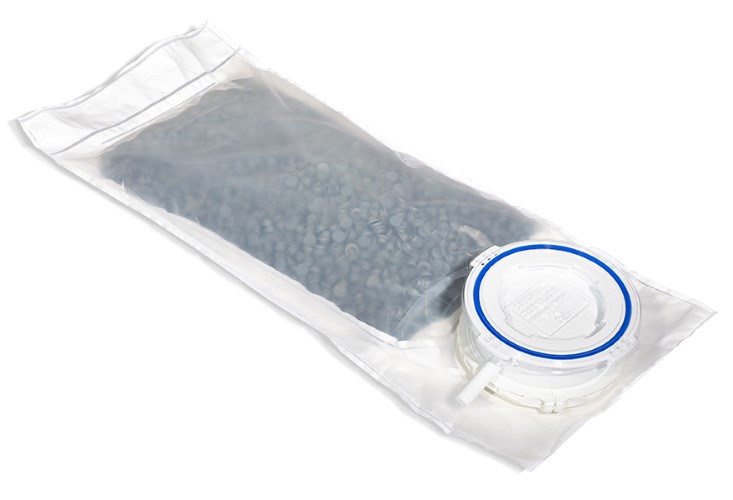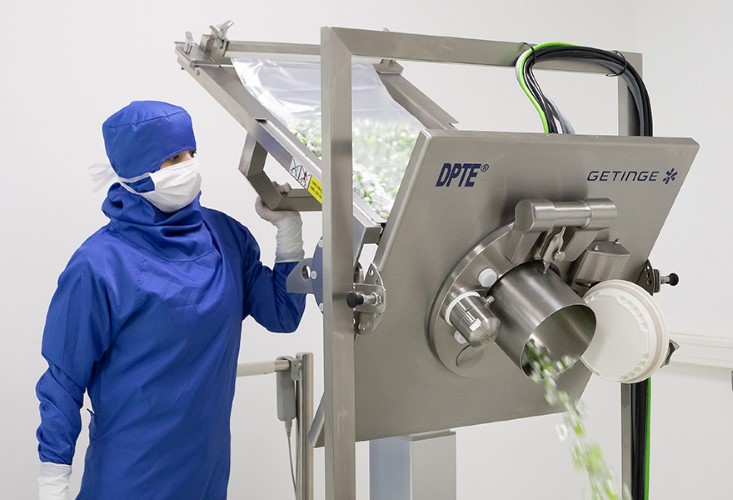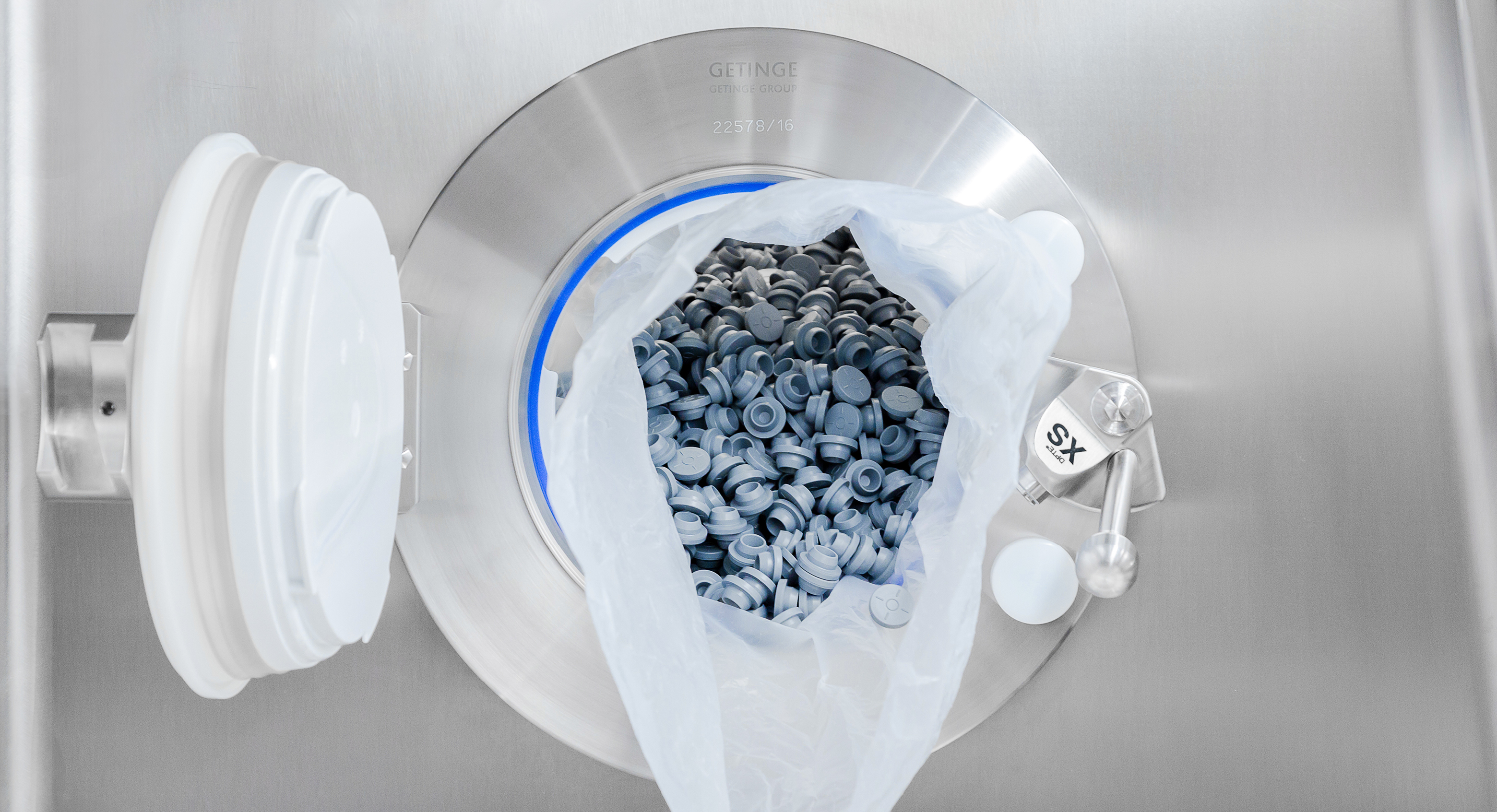4 key trends in sterile component transfer
While recent years have seen massive growth in the sterile transfer market due to COVID-19 vaccine production, other factors continue to fuel long-term growth. New innovations such as targeted immunotherapies and biologics for rare diseases along with increasing rates of chronic diseases associated with ageing populations are driving demand for flexible, validated component transfer solutions that require even less human intervention.
Getinge partners with companies such as West Pharmaceutical Services to help pharmaceutical companies and contract manufacturing organizations (CMOs) to achieve a future-proof set-up using the original Getinge DPTE® rapid transfer port and the pre-filled DPTE-BetaBag®.
“It’s the partnership between the companies that creates innovative solutions that meet the needs of pharmaceutical companies,” says Dave Milligan of Getinge. “We are always looking for challenges in the market,” says Whitney Winters, Senior Director of Strategic Marketing at West. “These insights drive our product development.”
Trend 1: Pre-validated component transfer with the DPTE-BetaBag®
When it comes to sterile transfer solutions, the complete Getinge DPTE® system has set the standard for over 40 years and it continues to lead the way. Today, around 45,000 DPTE® Alpha units are currently in operation worldwide, and Getinge has sold around 2 million DPTE-BetaBag® units.
In the past, the manufacturer would need to clean, sterilize, process and validate all their equipment and materials in-house. But now, with the single-use DPTE-BetaBag® filled with ready-to-use components, all these steps can be outsourced to Getinge and its sterile transfer partners, such as West. This not only speeds up production and reduces capital investment, it also brings down operating costs.
“When I started out at West, we sold rubber components that our customers then washed and sterilized,” says Whitney. “Now everything is ready to sterilize or use and customers have moved toward single-use rapid transfer bags. These bags are complex, so we buy them from partners like Getinge, who ensure they meet our customers’ quality standards. We all work together.”
Dave Milligan from Getinge agrees that the setup enables manufacturers to focus on their core: “Instead of spending time on stopper sterilization and processing, manufacturers can focus on drug development and production while benefitting from economies of scale.”

DPTE-BetaBag® Tyvek 190 filled with vial rubber stoppers
Trend 2: Manufacturing flexibility for the drugs of tomorrow
The trend toward single-use bags is also enabling greater manufacturing flexibility. As the market evolves, manufacturers are exploring more targeted treatments, immunotherapies, biologics and cell therapies. “To support future drug development, we need to create bag sizes that can fill smaller quantities in an agile way,” explains Dave.
Whitney agrees: “Drugs are getting incredibly specialized and that means batch sizes are getting smaller. Fills are getting smaller. We call it miniaturization, and you want your components to match your batch size.” That scalability also has implications for sustainability. “High-speed, large-volume lines need 25-liter bags, but with a small batch size, using a 5-liter bag will mean you’re not throwing away unused components,” says Dave. Throwing away 6,000 stoppers is not only inefficient, it’s also not sustainable.
Single-use also supports smaller fill lines that enable flexibility in manufacturing between batches. Previously, contamination control when switching between products was complex and required significant staff.
With single-use, there is little risk of contamination between batches, so changeover is much faster. You can essentially run one drug product, do a clean-out, and then run a second one rather than having dedicated lines or dedicated equipment for different things.
Trend 3: Increasing automation and quality
Drug manufacturers are always looking for ways to eliminate the risk of contamination by removing people from the manufacturing process as much as possible. “The rapid transfer port keeps people out and if we can automate more, we will do that,” explains Whitney. “For example, making rubber is very manual, but maybe one day stoppers will just be made onsite and flow onto a line.”
While that type of process is still years away, Getinge is also looking at ways to reduce the potential for contact with components. “The new automated and externally-operated DPTE®-EXO rapid transfer port eliminates glove-port intervention during component transfer,” says Dave. This will make the process easier and more efficient – and it goes hand-in-hand with the focus on increased quality. Getinge is also focused on finding ways to reduce particulate contamination by producing an even cleaner DPTE-BetaBag®.

DPTE®-EXO automated and externally operated rapid transfer port
“Component quality keeps getting better,” adds Whitney. “Today we are also looking at the processing of all the parts. How do we improve our wash process to eliminate more particles? What is the best way to sterilize these parts? We are designing processes that result in higher quality.”
West is also improving quality through vision inspection cameras that can pull out defective parts. “Quality should also be built into your development,” says Whitney. “If we are developing a new product, we start with the raw materials. Is this the highest quality raw material? We also look at the market and our customers for their feedback to see what needs or challenges exist.”
Capacity and speed to market are critical. Manufacturers need flexibility and fast revalidation, so we are seeing an increasing number of CMOs stepping in.
Trend 4: Continued market expansion
Prior to the COVID-19 pandemic, the sterile transfer market was growing by 15-20 percent a year. With COVID-19, that ramped up to 35-40 percent, and while this level isn’t permanent, growth is continuing.
“Even if you put COVID-19 aside, the injectable market is growing,” says Whitney. “Our investment in capacity has really grown over the last two years and we are expanding our plants and adding new equipment so that we can supply more.”
“We are trying to keep up with demand and get things closer to where they need to be used through facility expansions and new greenfield sites,” says Dave. “Capacity and speed to market are critical. Manufacturers need flexibility and fast revalidation, so we are seeing an increasing number of CMOs stepping in.”
Together, Getinge and West are helping to ensure safety and efficiency in drug manufacturing. The experts are processing the components and minimizing the risk, enabling the pharmaceutical companies to focus on what they do best.
Whitney Winters is Senior Director of Strategic Marketing at West. Backed by almost 100 years of experience, West delivers high-quality and technologically advanced containment and delivery solutions for pharmaceutical, biotechnology, generic and medical device companies.
David L. Milligan is Sales Director, Transfer Systems (Americas) at Getinge. David has both a B.S. & M.S. in Chemical Engineering and has been working with DPTE® for more than 20 years. With a focus on contamination prevention and upstream bioprocessing, Getinge Life Science provides tailored solutions for research laboratories and pharmaceutical production sites.
